File Info
| Exam | Avaya Aura Communication Applications Integration Exam |
| Number | 7130X |
| File Name | Avaya.7130X.PassGuide.2018-09-25.42q.vcex |
| Size | 2 MB |
| Posted | Sep 25, 2018 |
| Download | Avaya.7130X.PassGuide.2018-09-25.42q.vcex |
How to open VCEX & EXAM Files?
Files with VCEX & EXAM extensions can be opened by ProfExam Simulator.
Coupon: MASTEREXAM
With discount: 20%





Demo Questions
Question 1
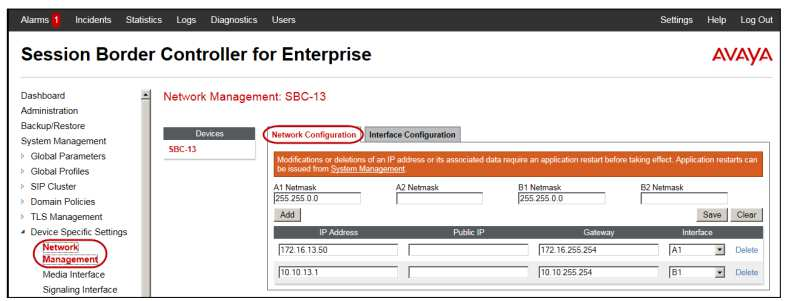
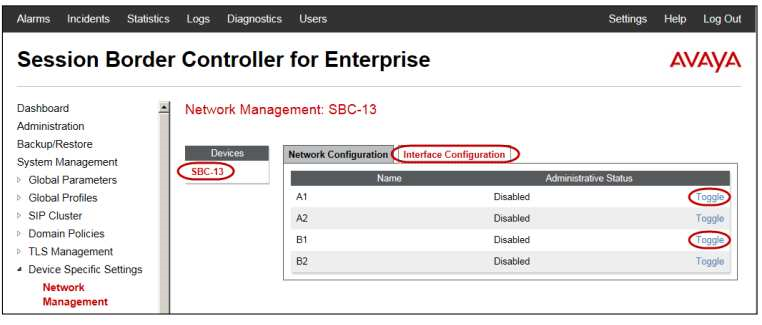

In the Avaya Session Border Controller for Enterprise (SBCE), before a traffic carrying Network Interface (A1 or B1) can be pinged, to which state do you have to
toggle the status on Device Specific Settings > Network Management / Interfaces?
- Enabled
- In-Service
- Accept Service
- Active
Correct answer: A
Explanation:
Commission the SBC—SBC Configuration 1. The A1 and B1 interfaces display on the Network Configuration tab: 2. Click on the Interface Configuration tab: 3. Click the Toggle link for both the A1 and the B1 interfaces. The Administrative Status for both A1 and B1 changes to Enabled: References: Avaya Aura Session Border Controller Enterprise Implementation and Maintenance (2012), page 203 Commission the SBC—SBC Configuration
1. The A1 and B1 interfaces display on the Network Configuration tab:

2. Click on the Interface Configuration tab:

3. Click the Toggle link for both the A1 and the B1 interfaces.
The Administrative Status for both A1 and B1 changes to Enabled:

References: Avaya Aura Session Border Controller Enterprise Implementation and Maintenance (2012), page 203
Question 2
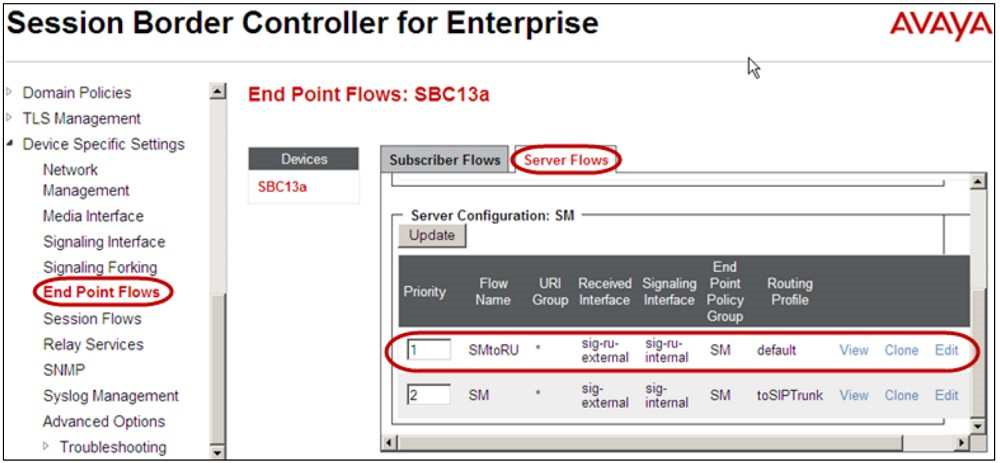
How many Server Flows and/or Subscriber Flows are required for SIP Trunking?
- one Subscriber Flow and two Server Flows
- a minimum of two Subscriber Flows
- one Subscriber Flow and one Server Flow
- a minimum of two Server Flows
Correct answer: A
Explanation:
Two types of flows need to be defined for the proper routing of SIP messages from and to the endpoints and the SIP server. Server Flows – Routing destination sent by SIP server (Session Manager). Subscriber Flows – Routing destination sent by SIP endpoints. Example, Server Flows: References: Avaya Aura Session Border Controller Enterprise Implementation and Maintenance (2012), page 540, 546 Two types of flows need to be defined for the proper routing of SIP messages from and to the endpoints and the SIP server.
- Server Flows – Routing destination sent by SIP server (Session Manager).
- Subscriber Flows – Routing destination sent by SIP endpoints.
Example, Server Flows:

References: Avaya Aura Session Border Controller Enterprise Implementation and Maintenance (2012), page 540, 546
Question 3
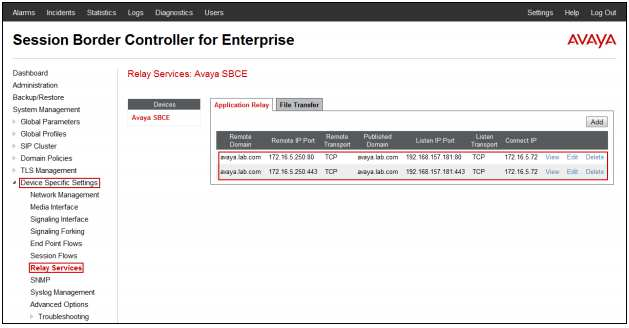
In Avaya Session Border Controller for Enterprise (SBCE) 7.x, you need to download the 46xxsettings.txt file to a Remote Worker device.
What needs to be configured under DMZ Services > Relay Services?
- Application Relay and File Transfer
- Reverse Proxy
- Application Relay
- Application Relay and Reverse Proxy
Correct answer: C
Explanation:
Relay Services are used to define how file transfers (e.g., for phone firmware upgrades and configuration), are routed to the Remote Worker endpoints. Example: 2 For accessing the file server using HTTPS protocol The following screenshot shows the newly created Relay Services References: Configuring Remote Workers with Avaya Session Border Controller for Enterprise Rel. 6.2, Avaya Aura Communication Manager Rel. 6.3 and Avaya Aura Session Managers Rel. 6.3 - Issue 1.0, page 73 https://downloads.avaya.com/css/P8/documents/100183254 Relay Services are used to define how file transfers (e.g., for phone firmware upgrades and configuration), are routed to the Remote Worker endpoints.
Example: 2 For accessing the file server using HTTPS protocol
The following screenshot shows the newly created Relay Services

References: Configuring Remote Workers with Avaya Session Border Controller for Enterprise Rel. 6.2, Avaya Aura Communication Manager Rel. 6.3 and Avaya Aura Session Managers Rel. 6.3 - Issue 1.0, page 73
https://downloads.avaya.com/css/P8/documents/100183254
Question 4

When planning the Avaya Session Border Controller for Enterprise (SBCE) for SIP Trunking, what is a good practice to adopt?
- Name Interfaces consistently, for example, A1 for Internal network to Call Server and B1 for external to Trunk Server.
- Name all internal and external interfaces exactly the same.
- Use the same IP address on both, internal and external sides of the network.
- Use one Avaya Session Border Controller for Enterprise on the internal and external sides of the network.
Correct answer: A
Explanation:
Use the same interface mapping throughout! Examples in this section use:A1 as the internal interface (to the call server) B1 as the external interface (to the trunk server) References: Avaya Aura Session Border Controller Enterprise Implementation and Maintenance (2012), page 304 Use the same interface mapping throughout! Examples in this section use:
- A1 as the internal interface (to the call server)
- B1 as the external interface (to the trunk server)

References: Avaya Aura Session Border Controller Enterprise Implementation and Maintenance (2012), page 304
Question 5

You want to multiplex all remote workers SIP messages to Avaya Aura® Session Manager (SM) over the same TCP connection, rather than open a dedicated TCP connection for each user. Which feature needs to be enabled for Avaya Session Border Controller for Enterprise (SBCE)?
- the Enable Grooming feature in the Advanced tab of the Avaya Aura® Session Manager (SM) Server Profile
- the Enable Shared Control feature in the Signaling Interface.
- the Stream Users Over Transport Link feature in the Signaling Interface
- the Share Transport Link feature in the Advanced tab of the Avaya Aura® Session Manager (SM) Server Profile
Correct answer: A
Explanation:
Example: References: Configuring Remote Workers with Avaya Session Border Controller for Enterprise Rel. 6.2, Avaya Aura® Communication Manager Rel. 6.3 and AvayaAura® Session Managers Rel. 6.3 - Issue 1.0, page 36 https://downloads.avaya.com/css/P8/documents/100183254 Example:

References: Configuring Remote Workers with Avaya Session Border Controller for Enterprise Rel. 6.2, Avaya Aura® Communication Manager Rel. 6.3 and Avaya
Aura® Session Managers Rel. 6.3 - Issue 1.0, page 36
https://downloads.avaya.com/css/P8/documents/100183254
Question 6
A field engineer runs the Installation Wizard to install the Avaya Session Border Controller for Enterprise (SBCE).
Which statement about the Domain Name Service (DNS) configuration is true?
- A DNS address always needs to be configured for both the Primary and Secondary DNS, even if only the DNS is available.
- A DNS address does not need to be configured.
- A DNS address needs to be configured, even if it is unused and/or unreachable.
- A DNS address should not be configured here.
Correct answer: C
Explanation:
The system requires the DNS server to resolve the host names for alarming and remote access name associated with the Avaya Service Center. You must supply a DNS address entry, even if it is unused and/or unreachable. Incorrect Answers:A: The Secondary DNS address is optional.References: Installing and Configuring Avaya Aura® Session Border Controller (November 2010), page 121https://downloads.avaya.com/css/P8/documents/100134970 The system requires the DNS server to resolve the host names for alarming and remote access name associated with the Avaya Service Center.
You must supply a DNS address entry, even if it is unused and/or unreachable.
Incorrect Answers:
A: The Secondary DNS address is optional.
References: Installing and Configuring Avaya Aura® Session Border Controller (November 2010), page 121
https://downloads.avaya.com/css/P8/documents/100134970
Question 7
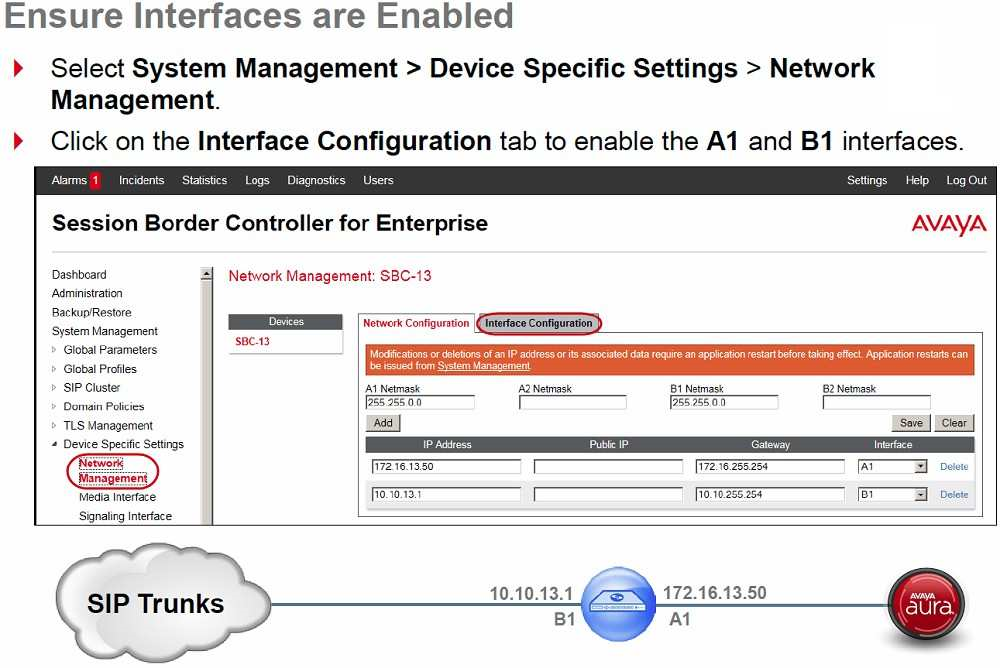
A company is deploying Avaya Session Border Controller for Enterprise (SBCE) to support SIP trunking.
What is the minimum number of IP-addresses they need to assign to the private and public Network Interface Cards (NICs)?
- Two addresses are assigned to the private NIC and two addresses are assigned to the public NIC.
- One address is assigned to the private NIC and one address is assigned to the public NIC.
- Two addresses are assigned to the private NIC and one address is assigned to the public NIC.
- One address is assigned to the private NIC and two addresses are assigned to the public NIC.
Correct answer: B
Explanation:
Example configuration: References: Avaya Aura Session Border Controller Enterprise Implementation and Maintenance (2012), page 305 Example configuration:

References: Avaya Aura Session Border Controller Enterprise Implementation and Maintenance (2012), page 305
Question 8
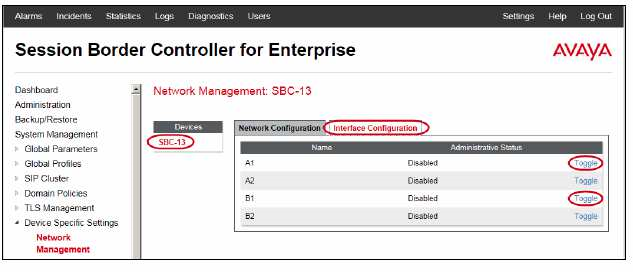
In Avaya Session Border Controller for Enterprise (SBCE), what is the default state of an Interface?
- Deployed
- Enabled
- Disabled
- Active
Correct answer: C
Explanation:
Example:Commission the SBC—SBC Configuration 1. The A1 and B1 interfaces display on the Network Configuration tab. 2. Click on the Interface Configuration tab: 3. Click the Toggle link for both the A1 and the B1 interfaces. The Administrative Status for both A1 and B1 changes to Enabled:References: Avaya Aura Session Border Controller Enterprise Implementation and Maintenance (2012), page 203 Example:
Commission the SBC—SBC Configuration
1. The A1 and B1 interfaces display on the Network Configuration tab.
2. Click on the Interface Configuration tab:

3. Click the Toggle link for both the A1 and the B1 interfaces.
The Administrative Status for both A1 and B1 changes to Enabled:
References: Avaya Aura Session Border Controller Enterprise Implementation and Maintenance (2012), page 203
Question 9
To set Timers, URI Manipulation, and Header Manipulation that the Avaya Session Border Controller for Enterprise (SBCE) will use when signaling to the far-end server; a profile like “avaya-ru” is provided by default.
When configuring the Server Configuration, you must link to which type of Global profile?
- Signaling
- Routing
- Topology Hiding
- Server Interworking
Correct answer: D
Explanation:
The standard Avaya profile “avaya-ru” is cloned for the Call Server Interworking Profile. The Interworking function of the Global Profiles feature enables the SBCE to function in an enterprise VoIP network using different SIP protocols. References: Avaya Aura Session Border Controller Enterprise Implementation and Maintenance (2012), page 339 The standard Avaya profile “avaya-ru” is cloned for the Call Server Interworking Profile.
The Interworking function of the Global Profiles feature enables the SBCE to function in an enterprise VoIP network using different SIP protocols.
References: Avaya Aura Session Border Controller Enterprise Implementation and Maintenance (2012), page 339
Question 10
On Avaya Session Border Controller for Enterprise (SBCE), where do you access the tool that displays SIP messages, in real time, as they pass through the SBCE?
- from Avaya Aura® System Manager, navigate to “Session Border Controller for Enterprise > SBCE Administration” menu
- from the SBCE EMS Web Console
- from the SBCE Server command line via SSH session, using PuTTY
- from the traceSIP client installed on a local PC
Correct answer: C
Explanation:
Stat the tue Tracing Tools, TraceSM, SSH to Session Manager Launch PuTTY (or similar client application) for a SSH session to Session Manager (port 22). Use the Session Manager IP Address (172.16.255.107). Log in. At the Session Manager command line type traceSM –x and press Enter. Note: The traceSM tool shows the SIP call flow in Session Manager.It gives insight into Session Manager’s decisions. Benefit: can filter certain types of SIP messagesShows the state of the dialog Displays changes in real time References: Avaya Aura Session Border Controller Enterprise Implementation and Maintenance (2012), page 485 Stat the tue Tracing Tools, TraceSM, SSH to Session Manager
- Launch PuTTY (or similar client application) for a SSH session to Session Manager (port 22). Use the Session Manager IP Address (172.16.255.107).
- Log in.
- At the Session Manager command line type traceSM –x and press Enter.
Note: The traceSM tool shows the SIP call flow in Session Manager.
It gives insight into Session Manager’s decisions.
Benefit: can filter certain types of SIP messages
- Shows the state of the dialog
- Displays changes in real time
References: Avaya Aura Session Border Controller Enterprise Implementation and Maintenance (2012), page 485

